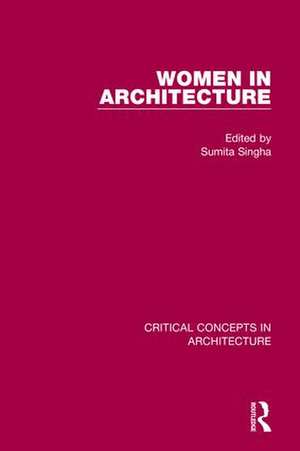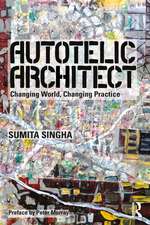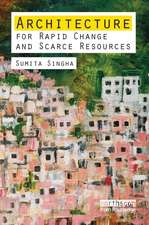Women in Architecture: Critical Concepts in Architecture
Editat de Sumita Singhaen Limba Engleză Hardback – 16 aug 2018
Preț: 8698.33 lei
Preț vechi: 10607.71 lei
-18% Nou
Puncte Express: 13047
Preț estimativ în valută:
1665.22€ • 1730.91$ • 1380.64£
1665.22€ • 1730.91$ • 1380.64£
Carte disponibilă
Livrare economică 17-31 ianuarie 25
Livrare express 03-09 ianuarie 25 pentru 28.57 lei
Preluare comenzi: 021 569.72.76
Specificații
ISBN-13: 9781138832930
ISBN-10: 1138832936
Pagini: 1436
Ilustrații: 105
Dimensiuni: 156 x 234 x 118 mm
Greutate: 0.45 kg
Ediția:1
Editura: Taylor & Francis
Colecția Routledge
Seria Critical Concepts in Architecture
Locul publicării:Oxford, United Kingdom
ISBN-10: 1138832936
Pagini: 1436
Ilustrații: 105
Dimensiuni: 156 x 234 x 118 mm
Greutate: 0.45 kg
Ediția:1
Editura: Taylor & Francis
Colecția Routledge
Seria Critical Concepts in Architecture
Locul publicării:Oxford, United Kingdom
Public țintă
Postgraduate, Professional, and UndergraduateCuprins
Volume 1: History and identity
Contents
Acknowledgments
Introduction: The ‘Vanished’, the ‘Immodest’ and the ‘Other Other’: The Virtues of Women in Architecture, Sumita Singha
Contents
Acknowledgments
Introduction: The ‘Vanished’, the ‘Immodest’ and the ‘Other Other’: The Virtues of Women in Architecture, Sumita Singha
- Julie Willis, ‘Invisible Contributions: The Problem of History and Women Architects’, Architectural Theory Review 3, 2, 1998, 57-68.
- Doreen Massey, ‘Space, Place and Gender’, in Iain Borden, Barbara Penner and Jane Rendell (eds), Gender Space Architecture: An Interdisciplinary Introduction (Routledge: London, 2000), pp.128-133. Originally published in Space, Place Gender (Polity Press: Cambridge, 1994), pp. 185-190.
- Jaime Gillin, ‘Pakistan’s First Female Architect, Questions and Answers’, Dwell Magazine, July 2, 2012.
- Bridget Fowler and Fiona Wilson, ‘Women Architects and Their Discontents’, Architectural Theory Review 17, 2-3, 2012, 199-215.
- Karen Burns, ‘The Woman/Architect Distinction’, Architectural Theory Review 17, 2-3, 2012, 234-244.
- Özlem Erdoğdu Erkarslan, ‘Turkish Women Architects in the Late Ottoman and Early Republican Era, 1908–1950’, Women's History Review 16, 4, 2007, 555-575.
- Norma Isa Figueroa, ‘Hard Hats and Aprons: Pioneering Female Architects Portrayed by the Press in Puerto Rico’, Architectural Theory Review 17, 2-3, 2012, 260-279.
- Despina Stratigakos, ‘The Good Architect and the Bad Parent: On the Formation and Disruption of a Canonical Image’, The Journal of Architecture 13, 3, 2006, 283-296.
- Mary McLeod, ‘Perriand: Reflections on Feminism and Modern Architecture’, Harvard Design Magazine, No. 20, Spring/Summer 2004.
- Naomi Stead, ‘Architectural Affections: On Some Modes of Conversation in Architecture, Towards a Disciplinary Theorisation of Oral History’, Fabrications 24, 2, 2014, 156-177.
- Julie Collins, ‘A "Powerful, Creative History": The Reticence of Women Architects to Donate Their Professional Records to Archival Repositories’, Archives and Manuscripts 40, 3, 2012, 181-190.
- Beatriz Colomina, ‘Battle Lines: E.1027’, Renaissance and Modern Studies 39, 1, 1996, 95-105.
- Mariela Cvetic, ‘Building A Room of One’s Own: An Insight into the Origins of Women Architects in Serbia’, unpublished, 2016.
- Alice T. Friedman, ‘Girl Talk: Marion Mahony Griffin, Frank Lloyd Wright and the Oak Park Studio: The Extraordinary Career of a Pioneering Woman Architect’, Places Journal, June 2011.
- Gabrielle Esperdy, The Incredible True Adventures of the Architectress in America’, Places Journal, September 2012.
- Karen Kingsley, ‘Gender Issues in Teaching Architectural History’, Journal of Architectural Education 41, 2, 1988, 21-25
- Linda N. Groat, ‘Architecture's Resistance to Diversity: A Matter of Theory as Much as Practice’, Journal of Architectural Education 47, 1, 1993, 3-10.
- Kay Standley, Bradley Soule and Jo Standley, ‘Women and Architecture’, Journal of Architectural Education 27, 4, 1974, 78-82.
- Bronwyn Hanna, ‘Australia's Early Women Architects: Milestones and Achievements’, Fabrications, The Journal of the Society of Architectural Historians, Australia and New Zealand 12, 1, 2002, 27-57.
- Karen Mcneill, ‘Julia Morgan: Gender, Architecture, and Professional Style’, Pacific Historical Review 76, 2, 2007, 229-268,
- Meredith L. Clausen, ‘The Ecole des Beaux-Arts: Toward a Gendered History’, Journal of the Society of Architectural Historians 69, 2, 2010, 153-161,
- Despina Stratigakos, ‘Architects in Skirts: The Public Image of Women Architects in Wilhelmine Germany’, Journal of Architectural Education 55, 2, 2001, 90-100.
- Suzette Worden and Jill Seddon, ‘Women Designers in Britain in the 1920s and 1930s: Defining the Professional and Redefining Design’, Journal of Design History 8, 3, 1995, 177-193.
Volume 2: Extraordinary Practice
Contents
Acknowledgments - Janie Grote, Matrix: A Radical Approach to Architecture’, Journal of Architectural and Planning Research 9, 2, 1992, 158-168.
- Hilary Macartney and translated by Zanna Gilbert, ‘Lina Bo Bardi: Three Essays on Design and the Folk Arts of Brazil’, West 86th: A Journal of Decorative Arts, Design History, and Material Culture 20, 1, 2013, 110-124.
- Caroline Constant, ‘E. 1027: The Nonheroic Modernism of Eileen Gray’, Journal of the Society of Architectural Historians 53, 3, 1994, 265-279.
- Michael Brenson, ‘Maya Lin’s Time’, in Acts of Engagement: Writings on Art Criticism and Institutions, 1993-2002 (Rowman and Littlefield, 2004), pp.167-189.
- Ann Forsyth, ‘In Praise of Zaha: Women’, Partnership, and the Star System in Architecture’, Journal of Architectural Education 60, 2, 2006, 63-65.
- Jenny Pickerill, ‘Bodies, Building and Bricks: Women Architects and Builders in Eight Eco-communities in Argentina, Britain, Spain, Thailand and USA’, Gender, Place & Culture 22, 7, 2015, 901-919.
- Caroline Roux, ‘Kazuyo Sejima Can Foresee the Future of Architecture’, The Gentlewoman, Spring and Summer 2010, 60-65.
- Igea Troiani, ‘Zaha: An Image of "The Woman Architect"’, Architectural Theory Review 17, 2-3, 2012, 346-364.
- Julie Willis, ‘Aptitude and Capacity: Published Views of the Australian Woman Architect’, Architectural Theory Review 17, 2-3, 2012, 317-330.
- Chad Schwartz, Laura Morthland and Shannon Mcdonald, ‘Building a Social Framework: Utilising Design/Build to Provide Social Learning Experiences for Architecture Students’, Architectural Theory Review 19, 1, 2014, pp. 76-91
- Pınar Kaygan, ‘Gender, Technology, and the Designer’s Work: A Feminist Review’, Design and Culture, The Journal of the Design Studies Forum 8, 2, 2016, 235-252.
- Guja Dögg Hauksdóttir, ‘The Search for Meaning Through Concrete: Matter and Mind in the Work of Högna Sigurðardóttir Architect’, The Journal of Architecture 20, 3, 2015, 489-509.
Volume 3: Wider Influence
Contents
Acknowledgments - Sonja Dümpelmann, ‘The Landscape Architect Maria Teresa Parpagliolo Shephard in Britain: Her International Career 1946–1974’, Studies in the History of Gardens and Designed Landscapes 30, 1, 2010, 94-113.
- Mark K. Smith, ‘Henrietta Barnett, Social Reform and Community Building’, The Encyclopaedia of Informal Education, 2007.
- Mark K. Smith, ‘Octavia Hill: Housing, Space and Social Reform’, The Encyclopaedia of Informal Education, 2007.
- Judith B. Tankard, ‘Defining Their Turf: Pioneer Women Landscape Designers’, Studies in the Decorative Arts 8, 1, 2000-2001, 31-53.
- Jenny Fortune, 'I am the Mother and the Father: Women in Construction in Cuba’, International Journal of Cuban Studies 2, 1/2, Spring/Summer 2010, 147-156.
- David Satterthwaite, ‘Introduction’, Barbara Ward and the Origins of Sustainable Development (International Institute for Environment and Development, 2006), pp. 6-14.
- Wendy Davis, ‘Women’s Design Service: Women Helping Women’, newly written for this volume (unpublished),
- Petra L. Doan, ‘The Tyranny of Gendered Spaces – Reflections from Beyond the Gender Dichotomy’, Gender, Place & Culture 17, 5, 2010, 635-654.
- Paul Holden, Review of ‘Architects, Angels, Activists and the City of Bath, 1765–1965: Engaging with Women's Spatial Interventions in Buildings and Landscape’, Planning Perspectives 28, 4, 2013, 653-655.
- Sara Ortiz Escalante and Blanca Gutiérrez Valdivia ‘Planning from Below: Using Feminist Participatory Methods to Increase Women's Participation in Urban Planning’, Gender & Development 23, 1, 2015, 113-126.
- Alexandra Lange, ‘Founding Mother: Mariana Griswold Van Rensselaer and the Rise of Architecture Criticism’, Places Journal, February 2013.
- Sherry Ahrentzen, ‘The Space between the Studs: Feminism and Architecture’, Signs 29, 1, 2003, 179-206.
- Thaisa Way, ‘Designing Garden City Landscapes: Works by Marjorie L. Sewell Cautley, 1922–1937’, Studies in the History of Gardens and Designed Landscapes 25, 4, 2005, 297-316.
- Deneen M. Hatmaker, ‘Practicing Engineers: Professional Identity Construction through Role Configuration’, Journal of Engineering Studies 4, 2, 2012, 121-144.
- Mona Domosh and Liz Bondi, ‘Remembering the Making of Gender, Place and Culture,’ Gender, Place & Culture 21, 9, 2014, 1063-1070.
- Jasmine Rault, ‘Designing Sapphic Modernity’, Interiors 1, 1, 2010, 29-43.
- Barbara Czarniawska, ‘Women, the City and (Dis)Organizing’, Culture and Organization 16, 3, 2010, 283-300.
- James M. Vanderleeuw, Maria E. Sandovici and Christopher A. Jarmon, ‘Women City Leaders and Postmaterialist Values: Gender Differences in Economic Development Priorities’, Journal of Women, Politics & Policy 32, 3, 2011, 211-236.
- Merrill Schleier, ‘Ayn Rand and King Vidor's Film "The Fountainhead": Architectural Modernism, the Gendered Body, and Political Ideology’, Journal of the Society of Architectural Historians 61, 3, 2002, 310-331.
- Elizabeth Hornbeck, ‘Architecture and Advertising’, Journal of Architectural Education 53, 1, 1999, 52-57.
Volume 4: Employment and Education
Contents
Acknowledgments - Meltem Ö. Gürel and Kathryn H. Anthony, ‘The Canon and the Void: Gender, Race, and Architectural History Texts’, Journal of Architectural Education 59, 3, 2006, 66-76.
- Valerie Caven, Elena Navarro-Astor and Marie Diop, ‘A Cross-national Study of Accommodating and "Usurpatory" Practices by Women Architects in the UK, Spain and France’, Architectural Theory Review, 17, 2-3, 2012, 365-377.
- Clara Greed, Sandra Manley, Ann De Graft-Johnson, Why Do Women Leave Architecture, University of the West of England and RIBA Research Publication, 2003, pp. 1-53.
- Hilde Heynen, ‘Genuis, Gender and Architecture: The Star System as Exemplified in the Pritzker Prize’, Architectural Theory Review, 17, 2-3, 2012, 331-345.
- Amanda Roan and Noami Stead, ‘A "New Institutional" Perspective on Women’s Position in Architecture: Considering the Cases of Australia and Sweden’, Architectural Theory Review 17, 2-3, 2012, 378-398.
- Denise Scott Brown, ‘Room at the Top: Sexism and the Star System in Architecture’, in Dana Arnold (ed.), Reading Architectural History (Routledge, 2003), pp. 237-246.
- Ann De Graft-Johnson and Sandra Manley, ‘Towards Inclusion: Rethinking Architectural Education’, Construction Management and Economics 31, 8, 2013, 914-927.
- Gill Mathewson, ‘"Nothing Else Will Do": The Call for Gender Quality in Architecture in Britain’, Architectural Theory Review 17, 2-3, 2012, 245-259.
- Valerie Caven, ‘Career Building: Women and Non‐standard Employment in Architecture’, Construction Management and Economics 24, 5, 2006, 457-464.
- Karen Kingsley and Anne Glynn, ‘Women in the Architectural Workplace’, Journal of Architectural Education 46, 1, 1992, 14-20.
- Stephen Sewalk and Kandice Nietfeld, ‘Barriers Preventing Women from Enrolling in Construction Management Programs’, International Journal of Construction Education and Research 9, 4, 2013, 239-255.
- Sherry Ahrentzen and Kathryn H. Anthony ‘Sex, Stars, and Studios: A Look at Gendered Educational Practices in Architecture’, Journal of Architectural Education 47, 1, 1993, 11-29.
- Susan Shannon, ‘Architecture and Equity: Education and Practice’, Architectural Theory Review 1, 1, 1996, 48-62.
- Sandra L. Fielden, Marilyn J. Davidson, Andrew W. Gale and Caroline L. Davey, ‘Women in Construction: The Untapped Resource’, Construction Management and Economics 18, 1, 2000, 113-121.
- Mary Shepard Spaeth and Katarzyna Kosmala ‘Identification Through Disidentification: A Life Course Perspective on Professional Belonging’, Architectural Theory Review 17, 2-3, 2012, 216-233.
- Ann De Graft-Johnson, Sandra Manley and Clara Greed, ‘Diversity or the Lack of it in the Architectural Profession’, Construction Management and Economics, 23, 10, 2005, 1035-1043.
- Judith Gill, Rhonda Sharp, Julie Mills and Suzanne Franzway, ‘I Still Wanna be an Engineer! Women, Education and the Engineering Profession’, European Journal of Engineering Education 33, 4, 2008, 391-402.
- Judith Gill, Julie Mills, Suzanne Franzway and Rhonda Sharp ‘"Oh You Must Be Very Clever!" High‐achieving Women, Professional Power and the Ongoing Negotiation of Workplace Identity’, Gender and Education 20, 3, 2008, 223-236.
- Jane Wilkinson, Anette Olin, Torbjorn Lund, Ann Ahlberg and Monica Nyvaller, ‘Leading Praxis: Exploring Educational Leadership through the Lens of Practice Architectures’, Pedagogy, Culture and Society 18, 1, 2010, 67-79.
- Anders Bergström, ‘Architecture and the Rise of Practice in Education’, Architectural Theory Review 19, 1, 2014, pp. 10-21.
- Regina Davis, ‘Writing Multiculturalism into Architecture Curricula’, Journal of Architectural Education 47, 1, 1993, 30-37.
- Kathryn H. Anthony, ‘Designing for Diversity: Implications for Architectural Education in the Twenty-First Century’, Journal of Architectural Education 55, 4, 2002, 257-267.
- Sherry Ahrentzen and Linda N. Groat, ‘Rethinking Architectural Education: Patriarchal Conventions and Alternative Visions from the Perspectives of Women Faculty’, Journal of Architectural and Planning Research 9, 2, 1992, 95-111
Notă biografică
Sumita Singha is an architect, artist and academic. She is the author of Architecture For Rapid Change and Scarce Resources (Routledge 2012) and Autotelic Architect (Routledge 2016). Sumita has been involved with Women in Architecture since 1996 and was previously its Chair. She set up Architects For Change, the equality forum at the Royal Institute of British Architects in 2000. Sumita has been an active member of the RIBA since 1993 and was elected to its Council 2011-2014. Presently she is part of the RIBA Sustainable Development and Ethics Commission; and its Professional Conduct committee.
Descriere
With a comprehensive introduction, newly written by the editor, which places the collected materials in their historical and intellectual context, Women in Architecture is an essential work of reference and is sure to be welcomed by scholars, students, and practitioners as a vital one-stop resource.







